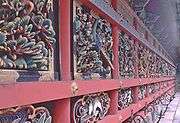Tōshō-gū

A Tōshō-gū (東照宮) is any Shinto shrine in which Tokugawa Ieyasu is enshrined with the name Tōshō Daigongen (東照大権現). Ieyasu was the founder of the Tokugawa shogunate (1603-1868), which is the third and last of the shogunal governments in Japanese history.
Tōshō-gū shrines are found throughout Japan. The most famous Tōshō-gū is located in Nikkō in Tochigi Prefecture. It is one of Japan's most popular destinations for tourists and is part of Shrines and Temples of Nikkō UNESCO World Heritage site. Ieyasu's son, the second shogun Hidetada, ordered the construction of the Nikkō Tōshō-gū. Later, the third shogun Iemitsu had the shrine greatly enlarged and lavishly decorated.
Ueno Tōshō-gū at Ueno Park in Tokyo is also widely known. The Kunōzan Tōshō-gū is in Shizuoka prefecture and rivals Nikkō's for decorative splendor. Another one is the Nagoya Tōshō-gū, constructed in 1619. A Tōshō-gū can also be found at Miyanochō, in Sendai.
During the Edo period, these shrines reached 500 in number. After the Meiji Restoration, many were abandoned, and others united with shrines in the area. Presently, there are about 130 Tōshō-gū.
Gallery
.jpg) Print from Yoshida Hiroshi's series 53 Stations on Tokaido Road, 1937
Print from Yoshida Hiroshi's series 53 Stations on Tokaido Road, 1937- Sake barrels at Nikkō Tōshō-gū
 Ueno Tōshō-gū after restoration work, 2014
Ueno Tōshō-gū after restoration work, 2014 Intricate carvings on Yomeimon (at Nikkō)
Intricate carvings on Yomeimon (at Nikkō) Nikkō Tōshō-gū shrine
Nikkō Tōshō-gū shrine Nikkō Tōshō-gū shrine in the 1930s
Nikkō Tōshō-gū shrine in the 1930s
See also
- List of Tōshō-gū
- Tourism in Japan
- List of World Heritage Sites in Japan
- Testament of Ieyasu
- Nikkō Tōshō-gū
- Mito Tōshō-gū
- Ueno Tōshō-gū
External links
- Toshogu.net (in Japanese)
- National Archives of Japan: Illustrations of Road to Nikko, Tempo 14 (1843)